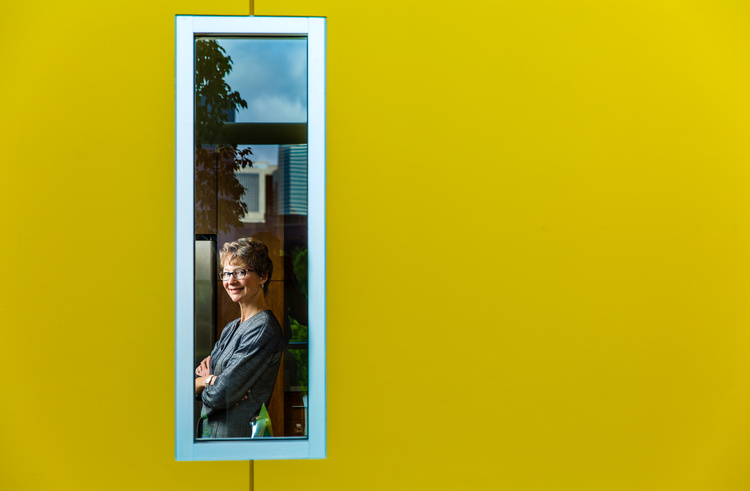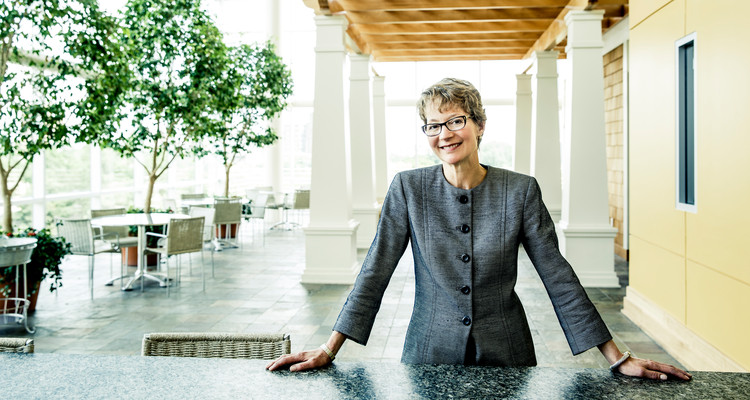In the public relations industry, two-way digital communications changed everything, according to Lynn Casey ’86 M.B.A. She would know. With more than three decades of industry experience, Casey is leading that change and, in the process, making the Twin Cities a national hub for the communications industry.
Casey entered the agency world in 1983 and has since risen through the ranks to chair and CEO of PadillaCRT, the largest independent PR firm in Minnesota. Casey began her most recent journey as CEO amid a turbulent, post-Sept. 11 economy at the end of 2001.
“It was a tough year, but a year that probably helped me grow more than three or four normal years would have,” Casey said. “I learned a lot. I had to make some really tough calls right away.”
Casey has made her mark on the Twin Cities. “You can’t think of the PR industry in Minnesota without Lynn’s name coming up,” said Doug Spong, owner of his agency, Spong, which is a competitor of PadillaCRT. This summer Twin Cities Business magazine added Casey to the Minnesota Business Hall of Fame. In the magazine’s profile, Adam Platt wrote, “By any objective measure, and many subjective ones, she’s the consummate success story.”
Casey now oversees 200 employee-owners in offices in Minneapolis; New York; Richmond and Norfolk, Virginia; Washington, D.C.; and Los Angeles, with global reach through the Worldcom Group. Revenue for 2013 was $32.3 million.
The importance of engaging in the community
At first, the responsibilities of simultaneously leading the firm and representing it in the community were difficult to juggle. “There was no such thing as balancing those first few years,” Casey said. “I had a big learning curve about what it means to be in a community like Minneapolis-St. Paul. Fortunately, a couple of CEOs took me under their wing and made sure I understood that the founders of our firm, Don Padilla and Dave Speer, were extraordinarily active in the community. So the challenge for me was managing the overcommitments that I made in my first few years in the local community with everything else that was going on, including learning how to be a CEO.
“People who buy your services want to know that you have the ability to see beyond the task at hand and bring a bigger worldview to whatever issue they’re asking you to help solve,” Casey explained. “I think that people want to do work with people they trust, and people who have an interest beyond the bottom line of their businesses.”
With this in mind, PadillaCRT has remained dedicated to public service. “When we say we’re committed to the community, we’re committed to the community. And that goes well beyond the CEO,” she added. “There hasn’t been a year, no matter how the economy is doing or how our business is doing, that we haven’t been able to fulfill our commitments to pro bono support.”
Casey sees giving back to the community as a valuable return on investment of the agency’s time and money. “It really is a virtuous circle,” she said. “A for-profit company that gives back meaningfully to the community knows that their contributions are going to result in a better quality of life, happier employees, and as long as those businesses keep their eye on the ball, investors will be proud to invest.”
Padilla acquires CRT/tanaka
Casey did, indeed, keep her eye on the ball. Last year, she orchestrated Padilla Speer Beardsley’s acquisition of CRT/tanaka, creating one of the top 10 independent public relations and communications firms in the country: PadillaCRT. A strong cultural alignment contributed to a smooth merging of the two.
“We had known each other for a while and had actually talked about and explored the idea earlier of combining forces,” Casey said. Since their initial conversations, CRT/tanaka had made two acquisitions in New York, “in the exact space that I wanted to be, and so I said it was probably time that we explored getting together,” Casey said. “We were both known for doing right by our people, extraordinary client service and a real passion for measurable results. Any one of those pieces could be up for debate in an acquisition or merger, but we were completely aligned on what was most important to us and that has made it work. We’ve accomplished more in these first nine months than I thought we would be able to accomplish in twice as much time.”
Spong reflected on the acquisition, “This merger is just part of the evolution of how the industry in Minnesota has matured and evolved. Lynn is certainly helping to lead that.”
Having earned her St. Thomas M.B.A. degree in 1986, Casey appreciates the value of a business education. “Especially if you’re in a corporate environment, the opportunity to understand the business of business that you get with an advanced degree is really valuable,” she said.
She noted two primary reasons for this: “Communications people often are accused of not being able to speak the language of business, and that can sometimes put up an unnecessary barrier between the ideas that they are trying to bring forward and the ability of senior management to really listen to them,” Casey explained. “Also, if you have some grounding in the numbers and in the business of business, it’s just a lot easier to get traction and to do the best work.”

Communications industry shift
In the last decade, the communications industry has experienced a shift from distinct types of firms to more all-in-one agencies. Today, “it is hard to distinguish between ad agencies, public relations firms, so-called branding firms, digital firms … the list goes on and on,” Casey said. “Most good agencies understand that the idea, if it’s driven by some insight that provides a point of difference for the company and a way to engage whoever’s important to them, should be executed in the best way possible through the best channel possible.” Sometimes the best channel is a paid ad and sometimes it’s through the third-party credibility of articles written by the media. Other times, it’s interacting directly with a consumer, which Web tools enable.
PadillaCRT was able to move fairly quickly in using Internet tools, “and we haven’t looked back,” Casey said.
The latest evolution in the communications industry is native advertising, sometimes called sponsored content. Native ad formats match both the form and function of the user experience in which they are placed. This might be a paid article appearing alongside traditional news content on the Internet, instead of a banner ad on the side. The intent is to make the paid advertising feel less intrusive and increase the likelihood users will click on it. Native advertising allows companies “to deliver something of value that was yes, paid for,” Casey explained, “but was still valuable information to consumers.”
As with any emerging field, the industry, including PadillaCRT, is continually learning more about native advertising and other channels. “There have been, and there will be, many
attempts until we develop a body of knowledge about what really works and what doesn’t,” Casey said. Whether it’s targeting the right people or the right channel among the myriad options, “It is tempting to see the Internet as open season on the consumer and hit them with everything you’ve got.” Instead, Casey suggests a good litmus test for native ads: “Can you seriously look yourself in the mirror after you have copywritten a native ad and answer yes to the question, ‘Did I deliver something of value to a reader?’”
In the process, communicators are building a body of knowledge and, thanks to analytics, have an opportunity to learn from actions and put that knowledge to use and improve the craft. “For people like me who can tolerate a fair amount of ambiguity and trial and error, this is a fantastic time to be in our business,” Casey said.
Bringing revenue to Minnesota
Experimentation such as this keeps Twin Cities firms at the forefront of the national communications industry. The PR, advertising and creative communications industry in town is disproportionately large given the size of our population. The Twin Cities rank as the 14th largest media market in the country, yet, according to Spong, “When you look at the revenue from the public relations industry in Minnesota and you compare that with other markets, we rank as the sixth or seventh largest PR market in the country. That means a lot of revenue comes to Minnesota because those clients believe they’re getting better service and higher value work from [our] firms in Minneapolis.”
What sets our market apart? We have a special camaraderie in the Twin Cities, Spong said, “where we cheer each other’s successes despite the fact that we also will compete with each other for business.”
“I think Lynn was way ahead of her time in terms of coopetition,” Spong said. “She is more concerned with raising the tide, because she knows if the tide rises, it’s going to float the PadillaCRT boat, but it’s also going to float everybody else’s boat. And if Minnesota looks like this great magnet for where some of our country’s best public relations work is coming out of, it’s going to benefit everybody. It attracts a stronger talent base from which we can all pick and choose. It attracts better clients who want to bring their business to Minnesota. Most of the clients of Lynn’s firm and mine are not even based in Minnesota and that [brings] economic wealth to the state.”
Even though the industry has changed, what Casey seeks in employees has not: “Curious people who are lifelong learners who have an innate ability to grasp concepts quickly and can function at a high level with several competing interests on their plate,” she said. “In addition, of course, the core skills of writing and critical thinking.” Casey looks for people who are engaged in outside activities, preferably at a leadership level, who are juggling a part-time job in addition to a full-time education or are over-scheduled with extracurricular commitments. “Because that shows me they are alive, they are engaged, they think about things other than the task at hand and they might be able to handle a very demanding job … of which anything in the PR business is,” she said.
The same qualities can be seen in Casey, whose direction and commitment to her agency and the Twin Cities have taken her to the top.
Read more from B. magazine.







